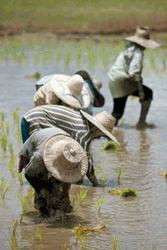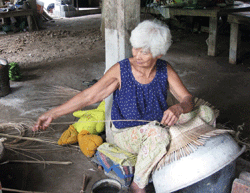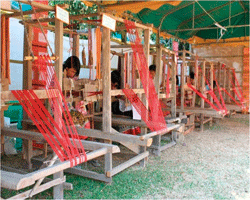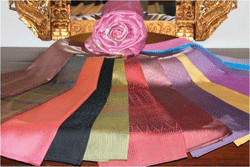
Handmade in Thailand: building brands for local communities
by Francesca Toso, Development Sector, WIPO

(Photo: iStockphoto/ © enviromantic)
Thailand's rural communities are overflowing with highly skilled artisans, many of whom are full-time rice farmers. The handcrafted products they create using age-old know-how and skills are a useful supplement to agricultural incomes and an important buffer against the vagaries of farming life. In 2011, for example, many of these communities were hit by the worst flooding in decades, with over 13 million people affected and 65 of the country's 77 provinces declared flood disaster zones. A steady income from high-quality, handcrafted products promises greater financial security for these rural dwellers.
WIPO Development Agenda initiative
In 2010, WIPO, in collaboration with the Thai government and King Mongkut University of Technology Thonburi (KMUTT), began supporting three rural communities in using the intellectual property (IP) system to boost the commercial value and viability of their artisanal products. The initiative is part of an innovative WIPO Development Agenda project that aims to support local business development through IP and branding. The handicrafts targeted under the project include some of the country's most emblematic products and reflect the breadth of Thailand's creativity, the depth of its local traditions and their significant commercial potential. They include the intricately woven wicker products crafted by the artisans of Bang Chao Cha, the colorful cotton textiles created in Mae Chaem and the sumptuous brocade silk produced in Lampoon.
These communities, along with the Thai authorities, are keen to develop their community businesses by enhancing the commercial value of their products through effective branding. “We operate in a highly competitive global market flooded with many similar products. Developing a brand that effectively communicates the origin of a product, its quality and the local materials and know-how used to produce it, as well as the identity of the producer, is a key element in making products more competitive and marketable,” notes Veeranan Nidlanuvong, Deputy Director of Thailand's Department of Industrial Promotion.
IP experts Fabrice Mattei and Akkharawit Kanjanaopas, partners in the Bangkok IP law firm Rouse International, are assisting WIPO in implementing the project in Thailand. As a first step, they evaluated the qualities and marketability of the products to determine the most suitable form of IP protection for them. They then assessed each community's training needs to ensure local businesses and institutions acquired a solid understanding of how to use distinctive signs – collective or certification marks, and geographical indications (GIs) – to support their branding efforts. These were important steps in meeting the project"s overarching objective, namely, to create conditions that would enable each of the target communities to boost the commercial value and marketability of their origin-based products.
“What each community will get [from the WIPO project] will be different because their needs vary, but in the end each will have a better capacity to use IP,” says Dr. Akkharawit. “We hope that each community will have learned from this experience and will be able to continue to leverage the value of their products. Importantly, each community will also be able to pass along its cultural heritage – something that would otherwise be lost.”
Bang Chao Cha's wicker ware
The central plains of Thailand are home to the country's largest rice-growing area. The region's distinctive landscape – dotted with paddy fields, small lakes and marshes interspersed with patches of semi-natural woodland and bamboo – is an inspiration for much of its art and culture. Within these fertile plains lies the village of Bang Chao Cha and its community of wicker weavers, mainly women, who use age-old techniques to produce a range of intricately woven bamboo goods, including baskets, bags and trays. These are sold throughout Thailand and, to some extent, internationally. The villagers work together in the community's Wicker Weavers' Cooperative, and are eager to develop their products and maximize their market value.

The traditional art of wicker weaving in Bang Chao Cha
(Photo: Rouse & Co. International, Intellectual Property)
The WIPO project team began working with Bang Chao Cha's weavers in 2010, introducing them, and the local authorities, to the world of IP. The team highlighted how industrial designs can protect the aesthetic aspects of handicrafts; the way in which copyright protects original creations; the role of trademarks in distinguishing products from those of competitors; and how GIs can help build the reputation of high-value, niche products. With this understanding, and keen to move forward in strengthening their business, the community's cooperative opted to begin developing a collective mark, an important first step in distinguishing their products from those of their competitors.
Maintaining the traditional skills and know-how employed in producing locally crafted goods is an ongoing challenge for artisans – one that is further compounded by the need to innovate to meet constantly evolving consumer tastes. Recognizing this dilemma, teachers and students from KMUTT worked closely with Bang Chao Cha's weavers, both old and young, to develop innovative traditional product designs.
“KMUTT product design students worked with students at the local Temple School to trigger their innovation capacity,” explains Nanthana Boonla-or, instructor at KMUTT's School of Architecture and Design. “This has been an extremely fruitful experience,” she notes, “and points to the many advantages that can flow from close university-community collaboration.”
“We have been inspired by the traditional bamboo rice containers and fish traps used in the olden days and have developed new products and designs. While we try to maintain traditional ways, we are also playing with the idea of introducing new functions, new proportions and colors,” notes Wanas, a KMUTT student working with the weavers.
WIPO and its partners have been working with the Weavers' Cooperative for two years on IP and business development issues, resulting in the development of a collective mark for “Bang Chao Cha Wicker Works”. This is now ready to be registered at the Department of Intellectual Property of Thailand in the name of the district authority.
Mae Chaem's colorful textiles

Teenchok in the making: Mae Chaem women at the loom

Traditional colors and patterns of Mae Chaem Teenchok
(Photos: Rouse & Co. International, Intellectual Property)
While agriculture is the mainstay of the rural community of Mae Chaem, in Thailand's northern Chiang Mai region, woven textiles are a useful secondary income source. The region's distinctive woven textiles with their characteristic animal, plant and floral prints, created using natural dyes, reflect the closeness of its people to their natural environment.
Known as teenchok, these textiles are an integral part of the lives of the women of Mae Chaem. “In Mae Chaem, we weave teenchok for our own use as well as for sale”, notes Kaysorn Kannyka, leader of the local weaving cooperative. “Each teenchok is unique in that each pattern is determined by the color of the cotton threads the weaver chooses and the imaginative patterns each weaver creates,” she explains. Working every day, a weaver could complete about two pieces of teenchok a month, but as farming, the main source of income, occupies the bulk of the women's time, it usually takes a month to complete one piece of teenchok.
Mae Chaem's community cooperative, recognizing the benefits of IP, had already taken steps to acquire GI status for its products. The WIPO project team helped finalize the process by guiding and advising the Cooperative on the code of practice and traceability requirements that guarantee the origin of Mae Chaem's products and their compliance with agreed production standards. These important steps made it possible to register the Mae Chaem Teenchok GI in Thailand.
“The distinctive characteristics of Mae Chaem's teenchok – the quality of the cloth and traditional methods of production – are such that a branding strategy underpinned by the registration of a GI is the best way forward. This will ensure that Mae Chaem's textiles stand out from similar cloth produced elsewhere,” explains Dr. Akkharawit. “Mae Chaem's GI status makes it possible to recount the story of its teenchok: a story about highly skilled artisans who invest significant time and energy in weaving their own variations of 16 traditional patterns, each with a different meaning, to create unique measures of cloth. With a registered GI, the community can begin to build its reputation as the producer of distinctive, high-quality products, carve a market niche and command premium prices for their cloth.”
The members of Mae Chaem's Cooperative are unabashed by the rigor and discipline they need to exercise to comply with the strict standards of production required to qualify for GI protection. They consider this a small price to pay for enhancing the reputation of their products and the promise of increased revenue. “Beyond the fact that it has allowed us to take pride in ourselves and our culture, the project is also increasing the quality of our products. We are now able to more effectively position our product and to work with a more reliable group of buyers. This helps improve the price of our cloth and the economic returns to the community”, notes Dr. Panya of the Technology Licensing Office and University Business Incubator of Chiang Mai University.
Lampoon's brocade silk
Known as Lampoon Yok Dok, the elaborate silk brocade produced in the Northern Lampoon district is an exquisite textile inspired by the Thai royal silk tradition and used by Thai high society. This lavish, high-quality cloth is already protected in Thailand as a GI.

Lampoon Silk Brocade manufacture enjoys the
patronage of Thailand's Queen Sirikit (Photo:
Rouse & Co. International, Intellectual Property)
“The GI registration helps limit the producers of the Lampoon Yok Dok silk to the Lampoon province only,” notes Pornraveed Poohareaon, Deputy Chief Executive, Lampoon local authority. “In addition to protecting the interests of the producers, it also helps control the quality and standard of the products. The GI label provides information about the characteristics of the fabric, including its pattern, the weaver's name and a unique identification number to ensure traceability.”
The WIPO team's role in Lampoon was to advise producers on ways to further leverage the GI status of their products, by focusing, in particular, on establishing marketing strategies and identifying potential buyers and distributors. It also involved supporting the community's participation in a European Union-funded project, whereby producers agreed to undergo a third-party certification process to guarantee the originality, traceability and high quality of their GI-protected silk brocade. This has further validated the community's strict quality controls, consolidated its brand and strengthened the export potential of its cloth.
Whether the target communities seek greater visibility in export markets, or aim to become household names in Thailand, the WIPO IP and Product Branding for Business Development project has been instrumental in raising community IP awareness and has laid the groundwork for these producers to more effectively commercialize their products. “The branding strategies we have put in place create an opportunity to expand into export markets where foreign buyers can learn about these products, their origin and their associated traditions,” notes Dr. Akkharawit.
Developing an effective IP strategy is an essential part of the commercialization process, but it is only a first step. In the remaining months of the project - up to mid-2013 - the team will work with the target communities to develop effective marketing and distribution strategies. While this guidance is invaluable, in the end success will largely hinge on the drive and entrepreneurial flair of the producers themselves. “It will be up to the communities themselves to drive the process and to set their own objectives for the future,” notes Dr. Akkharawit. In their hands lies the fate of “Handmade in Thailand” and the distinctive brands and ancient know-how it represents, as well as the promise of business development for generations to come.
Related links
- Thailand - Building Brands, Empowering Communities [video on YouTube]
The WIPO Magazine is intended to help broaden public understanding of intellectual property and of WIPO’s work, and is not an official document of WIPO. The designations employed and the presentation of material throughout this publication do not imply the expression of any opinion whatsoever on the part of WIPO concerning the legal status of any country, territory or area or of its authorities, or concerning the delimitation of its frontiers or boundaries. This publication is not intended to reflect the views of the Member States or the WIPO Secretariat. The mention of specific companies or products of manufacturers does not imply that they are endorsed or recommended by WIPO in preference to others of a similar nature that are not mentioned.